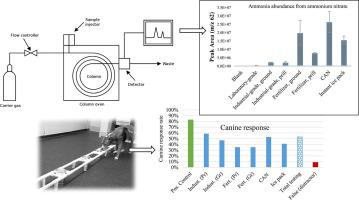Forensic Chemistry ( IF 2.6 ) Pub Date : 2021-06-06 , DOI: 10.1016/j.forc.2021.100342 Lauryn E. DeGreeff , Kimberly Peranich

|
Canines continue to be one of the most frequently deployed tool in the detection of explosives, and particularly homemade explosives (HMEs), in part, due to the ease in training to new HME materials as threats arise. The majority of HMEs encountered contain ammonium nitrate (AN), and previous research has measured the release of ammonia from AN, and found that the ammonia vapor concentration varies with form, purity, and environment, but this is has not been correlated to canine detection proficiency. In this research, the headspace analysis of AN variants was carried out using solid phase microextraction (SPME) with gas chromatography/mass spectrometry (GC/MS). Ammonia vapor from the AN was extracted using on-fiber derivatization, while the presence of other volatiles in the headspace of these variants were also characterized by a traditional SPME extraction. These results were correlated to canine testing, where canines previously trained in odor detection were provided laboratory-grade AN for odor imprinting, after which they were to locate other AN variants in a series of simple detection tasks. Headspace analysis showed variations in both the amount of ammonia as well as other volatile compounds in the headspace of the various AN samples, as well as changes in the vapor profiles due to changing environmental conditions. Canine data indicated that the differences in the headspace profiles of the samples may confound detection when canines were trained on laboratory-grade AN alone, while increased ammonia vapor availability from certain samples may have improved detection by this group of canines.
中文翻译:

硝酸铵变体的顶空分析以及不同蒸气分布对犬检测的影响
犬科动物仍然是检测爆炸物,尤其是自制爆炸物 (HME) 中最常用的工具之一,部分原因是在威胁出现时可以轻松训练新的 HME 材料。遇到的大多数 HME 都含有硝酸铵 (AN),之前的研究测量了从 AN 中释放的氨,发现氨蒸气浓度随形式、纯度和环境而变化,但这与犬类检测无关熟练程度。在本研究中,使用固相微萃取 (SPME) 和气相色谱/质谱 (GC/MS) 对 AN 变体进行顶空分析。来自 AN 的氨蒸气是通过纤维上衍生化提取的,而这些变体顶部空间中其他挥发物的存在也以传统的 SPME 提取为特征。这些结果与犬科动物测试相关,之前接受过气味检测训练的犬科动物被提供实验室级 AN 用于气味印记,之后他们将在一系列简单的检测任务中定位其他 AN 变体。顶空分析表明,各种 AN 样品顶空的氨和其他挥发性化合物的含量都发生了变化,并且由于环境条件的变化,蒸气分布也发生了变化。犬科动物数据表明,当犬科动物单独接受实验室级 AN 训练时,样本顶部空间轮廓的差异可能会混淆检测,











































 京公网安备 11010802027423号
京公网安备 11010802027423号